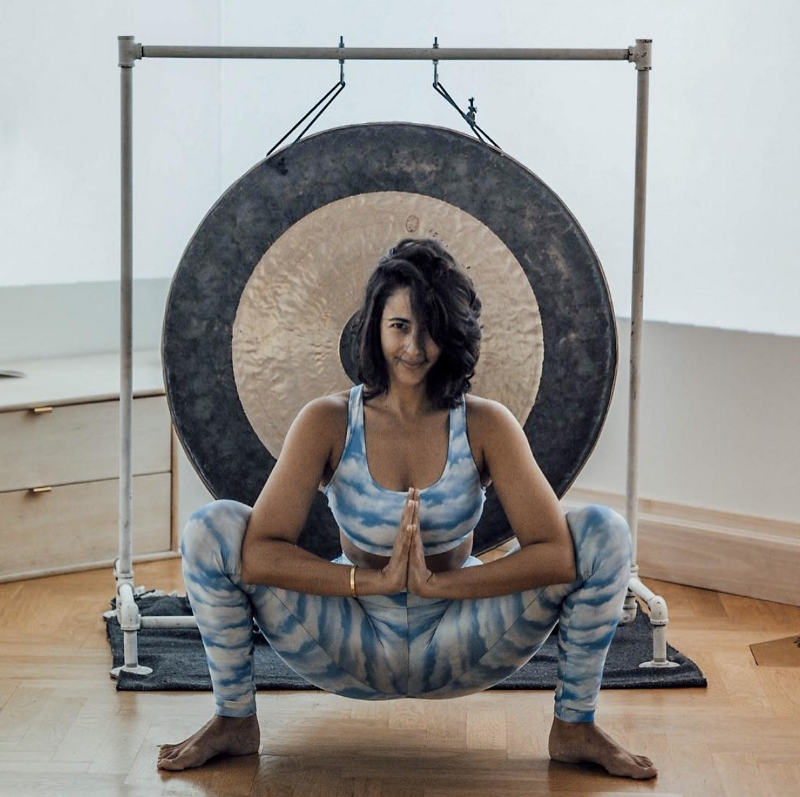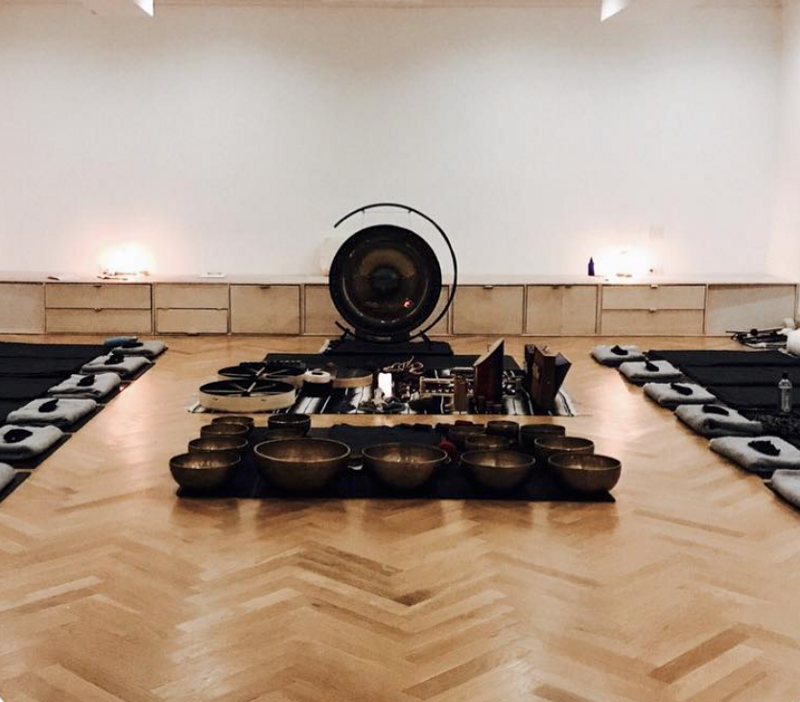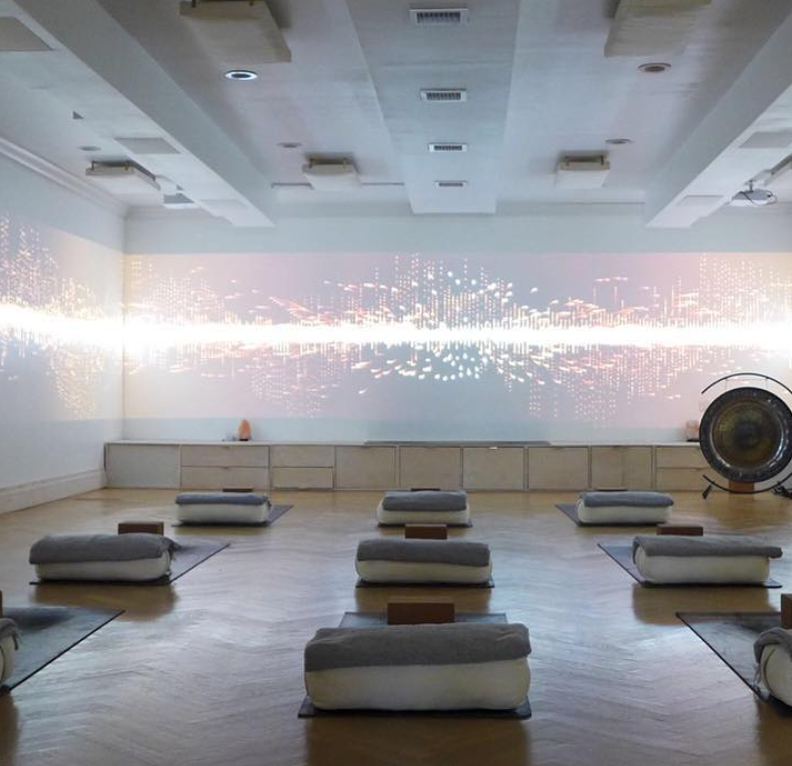
The holidays are oftentimes equal parts gratitude, excitement, and stress. It can be challenging to stay grounded and look after ourselves this time of year. How can we prepare for the sensory overload?
Today, we speak with sound practitioner, yoga teacher, and co-founder of NYC’s WOOM CENTER, Elian Zach, about how we can use sound and movement to calm and center ourselves.
Splendid Spoon: Hi Elian! Tell us about your journey to become a yogic sound practitioner.
Elian Zach: Hi Splendid humans! 12 years ago I moved to New York from my native Israel to study acting. Yoga became part of my life as soon as I moved here.
During the my first class I didn’t feel as though my body was learning new shapes, but rather remembering them. It felt familiar. When I realized acting was not my calling and left theater life, my yoga practice deepened and gave me a sense of purpose. Tears filled my eyes as I sat in the first session of my yoga teacher training: I felt right at home.
The same thing happened when I taught my first class. It was as if my whole life had led me to that moment, in the most elegant and playful of ways. That was the beginning of a very deep esoteric exploration, and a fascination with consciousness, spirit, and the ways of the universe.
My interest in sound came later. As I sat on a subwoofer at a party, I wondered about the effects of sound vibration on the skeletal, muscular, and nervous systems. I started to think about whether there could be any benefit to combining a very sophisticated sound system with ancient technologies, such as yoga, to promote wellbeing. I sought out an expert on this topic, which led my husband and I to our teacher, the ethnomusicologist [the study of music in its cultural context. — Ed.], sound practitioner, and researcher, Alexandre Tannous.

SS: How can we use movement and sound to center ourselves during the holidays?
EZ: Forward folds are calming, and you can never go wrong with a long child’s pose. A restorative yoga practice [Restorative yoga is a sequence which typically includes five or six poses held for at least five minutes. — Ed.] is always rejuvenating: it’s subtle but extremely powerful. Nadi Shodhana, or alternate nostril breathing, is another wonderful practice that restores balance and ease in mind and body.
Try humming to yourself. Bring your hands to your body, feel the power of your own voice, and allow the vibration to soothe you. You can also combine forward folds with humming. Move into child’s pose (or a restorative variation). Take a moment to settle in and assess what you need to feel fully supported. Unclench the jaw, let the tongue rest behind the bottom teeth, and release the face, head, neck, shoulders, butt, and toes. Take a deep breath in, and hum sweetly to the tips of your lips. Allow the hum to generate from the depths of the belly, and let it vibrate through your body. Repeat 10–20 times.
SS: If we’re doing a sound meditation for the first time, how should we approach it?
EZ: With an open mind, open heart, and without judgment or expectation. Remember that when we listen, we have an opportunity to learn something new about ourselves or life at large. Stay present and keep listening and engaging with the sound. It’s a great tool that can unlock and reveal realms both novel and familiar.

SS: Why does a sound meditation have a calming effect on us?
EZ: Our breathing, heart rate, and brainwave activity affect each other. Combining breathing practices with sound therapy can lower our heart rate and allow us to drop into a meditative theta brainwave state. This is the near-unconscious state connected to the hypnagogic states [the state immediately before falling asleep. — Ed.] that produce dreamlike imagery. Time and space cease to exist, but we’re able to process trauma, emotions, memories, etc., while remaining equanimous. The chatter of the overthinking monkey mind that provides us with our daily doses of stress and anxiety is significantly reduced, so we’re able to access deeper layers of our consciousness.
SS: What can we do to replicate how we feel after a sound meditation, in our own homes?
EZ: Infuse everything you do with curiosity and awareness.Take time to listen to music with eyes closed, even with an eye mask. Close your eyes when smelling things, tasting your food, or taking a shower.
You can also purchase a singing bowl or chimes and begin to play. We all possess an innate healing energy. When we facilitate a Sound Experience at WOOM, our aim is to hold space and create conditions that allow journeyers to feel safe and comfortable, so they can access that energy without fear or distraction. We can hold space for ourselves every day!

SS: Do you do anything extra to stay grounded during the holiday season?
EZ: I take advantage of this time of year to travel, as leaving and returning always gives me new perspective. Even if it’s just for a few days, I like to get out of the city and experience nature.
I love water, and my favorite self-care ritual is taking a candlelit bath with oils and salts. Burning palo santo is also wonderful for cleansing and grounding. I also love rose oil for balancing. I’m a sucker for good food, and potatoes are my go-to. They comfort and ground me like nothing else. I’m considering adding “potato” as my middle name.
